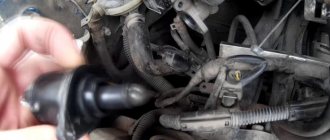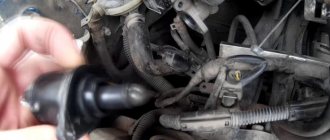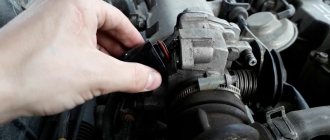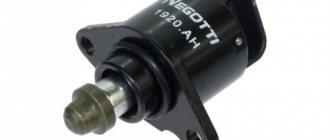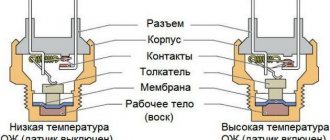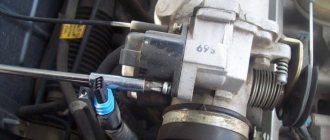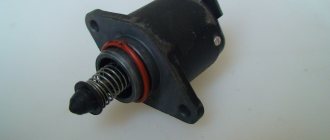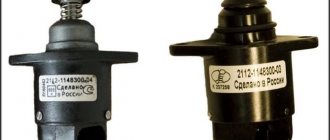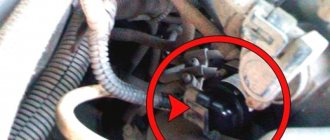The idle air regulator, also known as IAC, also known as the idle speed sensor, or idle air valve, is a very modest in size, but despite this, a very important component of your car. From the name you can already understand what function it performs - stabilizing engine idle speed by changing the flow area in the channel through which air passes.
Despite its modest size, the IAC plays a fairly important role in the car. Photo: marketingpluspr.ru
Location and principle of operation of the idle speed sensor
The idle speed control is located next to or on the throttle body. The location of the sensor may vary depending on the make of the vehicle. For example, on Opel and BMW models the regulator is remote, that is, located separately from the manifold.
In most cases, the IAC is secured with two bolts through a rubber O-ring and is located directly in the throttle valve. Difficulties in dismantling and installing the product may arise due to sticking of the bolts; if such a problem persists, then try the simplest method - drilling.
The main task of the IAC is to supply fuel at idle, which helps us save fuel consumption and maintain stable idle speed.
When the ignition is turned on, the sensor rod moves forward to its maximum length and rests against the hole in the throttle pipe.
After the required number of steps have passed, the valve returns to its original position. The number of steps is a constant value, which is set by the manufacturer. When you start the engine, you can watch on the tachometer how the revolutions drop as the engine warms up; this is a process that occurs due to the presence of a sensor.
The more the rod is pushed forward, the more steps are used in the work. The average stroke of the rod is 250 steps. According to this principle, the engine receives the required amount of air for its full operation, and thus the idle speed of the car is regulated. When the engine is not warmed up, thanks to the regulator, the speed increases, which allows you to start moving without fully warming up the engine.
Further work is carried out and adjusted by the mass fuel flow sensor; it analyzes the air entering the engine and gives a command to supply fuel based on the data received. Observing the engine speed, the controller begins to control the regulator. In this way, the required volume of air is monitored and further work is adjusted.
The main task of the IAC is more complete combustion of fuel due to air supply and, of course, reducing wear on the crankshaft bearings.
What does the valve consist of?
Structurally, the valve consists of a stepper electric motor, a four-position rod and a spring element. it also contains needles. The device is located near the throttle valve and TPS. Some vehicle models provide for fixing this sensor to the damper body. This is done using varnish. However, it also happens that the device is mounted on two bolts with mounting holes. In this mounting option, the main thing is that the distance from the needle to the mounting flange on the device is no more than 2.3 cm.
Device role
On injection engines that are installed on the VAZ 2110, the XX regulator serves to control the stable operation of the power unit. It is unlikely that you will be pleasantly surprised by a situation in which the idle speed starts to fluctuate, and every now and then the car will stall.
Some people do not know about another very important role of the idle speed sensor - warming up the power unit in case of low air temperature.
It is generally accepted that if there is an injector, there is no need to warm up the engine. The opinion is wrong. Do not overstress the engine, but first let it run for a while without increased speed. This will have a positive effect on the reliability and service life of the motor. .
Location
Externally, the IAC looks quite simple. It looks like a small electric motor. Its design includes three parts:
- Stepper motor;
- Spring;
- A rod with a needle at the end.
And the desired regulator is located near the mechanism that is responsible for changing the position of the throttle valve. There is no complex fastening system. To dismantle you just need to remove the mounting bolts.
How does he work
The function of the IAC is to regulate the amount of fuel supplied. He may indicate the need to increase or decrease the quantity. An important nuance is that the sensor performs its functions directly when the idle speed is turned on.
The actual action of increasing or decreasing occurs due to the extension or retraction of the needle at the end of the rod. The needle is responsible for closing or opening the special channel to the required extent.
Learning to distinguish a fake from an original
Today, many people complain about the abundance of counterfeit products on the auto parts market.
If we talk specifically about the XX regulator for the VAZ 2110, then there are several key signs by which a fake can be distinguished from the original. Be guided by these data so as not to accidentally install a device of dubious quality and origin on your car.
Fake and original
- On fakes, the black body made of metal is 1 millimeter shorter than the real part.
- In the case of the fake, the three white rivets on the case have no heads. They must be present in the original. And the diameter of the caps is 3 millimeters.
- On fakes, the spring is made in white and has more frequent winding. In the original, the coiling is less frequent, and the spring itself is black.
- Pay attention to the rubber ring of the regulator. On fakes it is black and thin, but in the case of a real part, a reddish tint is noticeable. Plus the thickness is greater.
- Take a closer look at the tip. In fakes it is darker compared to the original spare part.
- There are no markings on the counterfeit packaging; the boxes are noticeably different in appearance.
- The original yellow sticker located on the case must have an outer frame. Manufacturers of counterfeits apparently forgot about it.
Design features
The valve structurally consists of:
- electric stepper motor;
- four-position rod;
- spring element;
- needles.
When IACs first appeared, they were rotary or solenoid mechanisms. Such devices had two positions - open and closed. This contributed to a decrease in the efficiency of engine speed control. Today, cars use four-step sensors, characterized by the possibility of stepwise feed through the bypass.
The idle air control itself is classified as a consumable item and is therefore considered non-repairable. It can be repaired if it malfunctions, but it will be cheaper to replace it completely.
Where is RXX located?
The device should be located next to the throttle valve and TPS. In some cars, the sensor can be fixed directly to the damper body using varnish. Sometimes the device is mounted using two bolts equipped with special mounting holes. The main thing is that the distance from the needle to the mounting flange on the installed device is 2.3 cm.
Connection diagram
Idle air controller connection diagram
One harness consisting of four cables is connected to the idle speed sensor; it comes from the microprocessor module. As a result of this connection, diagnostics may cause certain difficulties. The car owner will not be able to simply apply voltage to the terminals of the device, since the microprocessor module does this pulsed.
Choosing IAC for Lanos, which one is better
Original IAC for Lanos
There are about two dozen regulators on sale from different manufacturers, however, according to reviews from owners, the following work most accurately and correctly:
- CRB regulator with catalog number 1309.2090/17059602 , price 150 hryvnia;
- suspicious, but slightly cheaper Autotrade with article number AT17059602 , price 140 hryvnia;
- original GM Continental with article number 17059602 , 180 hryvnia;
- Polish FSO 17059602-FSO, price 146 hryvnia;
- Korean KS 17059602/93744675 , price 165 hryvnia for 2022;
- the cheapest, Polish TackPart 17059602/93744675 , about 100 hryvnia;
- Korean RXX ANAM 17059602/93744675 .
Interesting on the topic: Servicing the Chevrolet Lacetti: how to replace the cabin filter. Choosing the best from the catalog
Non-original regulator XX
If possible, the public recommends installing a genuine GM (Continental) regulator, as step calibration accuracy may vary between manufacturers.
Share with your friends!
- Click to share on Twitter (Opens in new window)
- Click here to share content on Facebook. (Opens in a new window)
- More
- Click to share on LinkedIn (Opens in new window)
- Click to share on Pinterest (Opens in new window)
- Click to share on Telegram (Opens in new window)
- Click to share on Skype (Opens in new window)
- Send this to a friend (Opens in new window)
Signs of a malfunctioning idle speed sensor
The main problem will be that this part is not equipped with any type of self-diagnosis. On the control panel you will not see a flashing light or an inscription that will indicate a malfunction of the IAC. Everything will depend on your attentiveness and how you feel and hear your car. Signs that indicate that a part is worth checking include:
- the car began to stall at idle (uneven idle speed);
- a sharp drop or increase in speed during idle;
- when driving on a cold engine, the speed does not increase;
- When changing gear, the car stalls.
There are few reasons why the IAC failed. As they said earlier, this is a fairly reliable part, but it can still fail. There may be several reasons for the malfunction:
- The guide needle is worn.
- Broken contacts inside the part.
- The needle is clogged due to poor quality fuel.
As we all know, fuel is one of the most important components of the operation of both the engine and the car as a whole, and the idle speed sensor is no exception. Most of the reasons for part failure are the use of gasoline with impurities.
A malfunction and inadequate operation of the XX sensor is indicated by any changes in the engine speed. If the part fails completely, you will not be able to start the car without using the gas pedal. And such a procedure will negatively affect the operation of the vehicle as a whole. Manufacturers do not recommend this practice for nothing.
Signs of breakdown
Based on certain signs, it can be determined that the IAC is out of order and needs to be repaired or completely replaced with a new device.
These signs include:
- Floating idle speed;
- Problems with starting the engine; it starts with difficulty even with the gas pedal pressed;
- It is not possible to increase the speed even when the engine has warmed up sufficiently;
- The engine suddenly begins to stall when shifting into neutral;
- The speed decreases when you turn on energy-consuming devices - stove, air conditioner, audio system, headlights, etc.
But replacing the regulator is not always the right decision. In some cases, removing the old sensor and installing a new device in its place will not bring any results. And all because the culprits of the malfunction may be other elements, such as spark plugs or a fuel filter.
Functionality check
If the engine stalls, the speed fluctuates, or turns out to be high, you must definitely check whether the IAC is working.
To check, you will first need to dismantle the fastenings of the throttle assembly, and then carefully move it literally 10 millimeters.
You will need a voltmeter with which you can check whether there is voltage going to the sensor and what its indicators are. In advance, connect the negative terminal from the battery to ground, and connect the voltmeter to the terminals marked with the letters A and D. Next, check the table.
Indications
What do they mean
The voltmeter shows less than 12V
This means that the battery is most likely dead.
There is no data on the meter
The problem should be looked for in the wiring circuit or in the electronic engine control unit
Voltmeter shows 12V or more
Be sure to check the idle air control resistance. There are problems with him. The tester is connected to 4 pins. Normal resistance readings are 50 or 55 ohms
Additionally, do a pairwise check. In this case, the resistance should be infinitely large. If the XX sensor shows different numbers, then the regulator requires mandatory and immediate replacement.
There is another way to check the functionality of the device. To do this, you need to remove the sensor and connect the block. Press the needle with your finger and watch it extend. When the ignition is turned off, the needle should push.
If there is no shock, you can still try to solve the problem by simply cleaning the device. Use a universal and all-powerful product called WD40. Wet the entire mechanism thoroughly with it and, armed with cotton swabs, clean everything you can reach. When cleaning, pay special attention to the needle and stem.
If these measures do not help, there is nothing else left but to replace the IAC.
Checking the idle speed sensor
Diagnosing the part is quite easy, but pay attention to a few points. The first problem may be removing the part; most manufacturers attach the XX sensor to screws, and in extreme cases they can be drilled out, but in some variations the part is mounted on varnish. If your regulator is secured with varnish, be careful not to forcefully remove it, as this may damage the intake part of the car. In your case, it would be correct to completely dismantle the throttle assembly and only then disconnect the IAC.
The easiest way to check is, of course, visual inspection. During a visual inspection, the first thing you should pay attention to is whether the needle is dirty. Also pay attention to the condition of the contacts and the throttle valve itself.
If broken wires are found, they must be returned to their place. Solder them and, to avoid corrosion, treat them with varnish.
It would be appropriate, if possible, to check the IAC with a multimeter or a homemade tester. You can check the resistance with a multimeter, and use a homemade tester (you can make one from a mobile phone charger) to check the stroke of the regulator rod.
If you find that the motor is damaged, the rod is completely worn out, or the cone needle is worn out, the part will need to be replaced. Don’t be too upset about this, the cost of the part will only be about 1000 rubles.
Let's sum it up
As you can see, the idle speed sensor is an important and critical part in the ECM of a car engine. It is important to understand that the IAC is an electromechanical solution, that is, problems can arise in the electrical or mechanical parts.
We also recommend reading the article about what ELM327 is, what features the ELM327 scanner has, how this solution works and what functionality is available. From this article you will learn about the advantages of the ELM327 scanner, as well as what to look for when choosing this device before purchasing.
In this case, it is important that the sensor works correctly, that power is supplied to it, and that the ECU commands are carried out by the regulator accurately and in a timely manner. For this reason, it is necessary to check the electrical circuits, contacts and connectors, as well as the quality of operation of the regulator needle itself and other sensor elements.
Main aspects of checking IAC
We figured out how to clean the idle speed sensor, now we’ll take the time to diagnose it. Like cleaning, testing can be done at home.
How to check the idle speed sensor:
- Find the IAC and remove it along with the wires. Unscrew several clamps that secure the throttle assembly with the receiver, then move these elements apart by about 1 cm.
- Using a diagnostic tester, check the IAC circuit - now you should make sure whether there is voltage in the network or not. Connect the tester probes to contacts A and D - as a rule, they are marked on the body. Having connected the probes, you need to activate the ignition and look at the results. The best option is 12 volts. If this parameter is lower, then most likely the problem lies in a poor battery charge, and if it is completely absent, then it is quite possible that the problem lies in the control unit.
- Make sure that the circuit is on the IAC itself. To do this, the tester's probes must be connected to pins A and B, and then to C and D, and you need to set the tester to ohmmeter mode. When checked, the diagnostic parameters should be about 53 ohms. Then the same actions should be repeated with other pairs of contacts, for example A and C, and the resistance should tend to infinity (the author of the video is Ivan Vasilyevich).
There is another option; for this, checking the idle speed sensor must be carried out with the IAC removed. Connect the power cable, then touch the end of the needle with your finger (no force required). During shutdown, the regulator should begin to extend the needle fully, so when you turn, there should be a slight push of the finger.
As you can see, in general, diagnosing a device is not that difficult, but for a quality test you need to understand how to use the tester. If you have no idea how to do this, it is better to seek help from an electrician, but in practice, after studying the instructions for the multimeter, there should be no problems with its use. Of course, the tester itself must be working, otherwise the readings will not correspond to reality and you will only get confused.
First way
- Get a tester if you haven't had one before.
- Disconnect the DXX from the block with wires.
- If you have a 1.6-liter engine, then be sure to disconnect the throttle assembly fasteners and move it from the receiver about 1 centimeter.
- Use a voltmeter to check if voltage is being supplied to the regulator. The minus is connected to ground, and the plus goes to the block - use the AD pins.
- With the ignition on, the tester should show at least 12 W.
- If there is no voltage, then there is a problem in the power circuit or electrical unit of the car.
- If there is voltage, but it is significantly less than 12W, then this indicates a low charge level of your battery. Be sure to recharge the battery.
- After checking the circuit for efficient operation, proceed to study the DXR itself. At this stage the ignition is turned off.
- In turn, connect the terminals to the tester to pairs A-B and CD. The normal resistance should be approximately 53 ohms.
- Change the pairs to AC and BD. When measuring them, the resistance should turn out to be infinitely large.
If the check shows that the readings do not meet the standards, then several actions can be taken:
- Clean the contacts, throttle body, needle needle and other sensor components using carburetor cleaner. It is not difficult to find, and it is cheaper than specialized cleaners;
- If possible, try to repair the IAC;
- If it is impossible to carry out repairs, replace the old sensor with a new regulator.
Faulty sensor
How to disassemble the idle speed control (IAC)?
You should disassemble the idle speed sensor very carefully, otherwise we may completely break it.
- To disassemble the sensor, you first need to remove three studs that serve as a housing fixation.
- After removing the pins from the sensor, using little effort, carefully pull out the connector housing. Do not damage the wire contacts or tear them off.
- Look at the cause of the problem.
The simplest thing that can happen is a broken wire. In this case, solder the wire back and cover it with varnish. “Why varnish?” you ask – for protection against corrosion.
The needle guide drive or the guide itself could also be worn out. In this situation, there is nothing we can do except install a new sensor.
Replacement Guide
If problems are detected, the DXX must be changed.
If you don’t know how to replace the idle speed sensor on a VAZ 2110, then there’s nothing complicated about it:
- First, disconnect the battery, after which you can disconnect the power cord from the device. If we are talking about an injector, then to disconnect the block you only need to press the corresponding latch.
- After this, you need to unscrew the left and then the right mounting bolt. The sensor itself must be dismantled after these steps. The regulator being replaced must be removed, and then the rubber seal of the new device must be treated with motor fluid. It is better not to use an old seal, especially if it shows signs of damage or cracks. The controller installation area must be thoroughly wiped, after which the device can be installed and the connector with wires can be reconnected.
- Next, turn on the ignition for a few minutes, after which it will need to be turned off. This completes the replacement procedure, as you can see, there is nothing complicated about it.
Removing the device from the engine
Cleaning Rules
It often happens that cleaning the idle speed sensor can solve the problem of device inoperability. In general, this procedure is quite simple. Therefore, almost anyone can cope with it.
So, how to clean the idle air regulator:
- First of all, the IAC must be disconnected from the wiring.
- Next, take the WD-40 liquid and apply it to a Q-tip. This stick is used to clean contacts.
- Next, take a small Phillips head screwdriver and unscrew the controller latches, there are two of them. If the fastenings are completely missing, this indicates that the IAC is mounted on varnish; if this is the case, then, most likely, the entire throttle will need to be dismantled.
- Dismantle the DXX and inspect it. If there is dirt or traces of motor fluid on the device, then in addition to the regulator itself, you will need to clean the entire throttle assembly.
- Now take a cleaning fluid (you can use carburetor cleaner instead of WD-40) and apply it to the cone needle and spring. Although carburetor cleaner is better for cleaning! Having done this, you need to dry the controller and put it in place. Before installation, make sure that the distance from the device body to the needle is 2.3 cm. If cleaning does not help fix the problem, then most likely you will have to change the DHC.
Controller connection diagram
Articles
SIEMENS VDO D95177 Here are the catalog numbers of Logan idle speed sensors with different engines.
Engine 1.4 with eight valves - original RENAULT article number 7701-206-370 or SIEMENS VDO D-95-177; analogue of ERA 556-038.
Engine 1.6 with eight valves - original RENAULT part number 7701-047-909 or SIEMENS VDO D-95-174; analogue of ERA 556-012.
1.6 engine with sixteen valves - original RENAULT part numbers 7700-102-539, 8200-299-241, 8200-692-605 or SIEMENS VDO D-951-66; analogue of ERA 556-037.
RENAULT 8200-692-605
The article number of the lower RENAULT sealing ring is 7701047579. The catalog number of the upper one is 7701069213.
The sensor can be purchased either original or a high-quality analogue.
The process of cleaning the idle speed sensor
To stabilize the operation, a cleaning process is required, especially if during inspection you find a clogged needle or throttle valve. To clean the contacts, use a cotton pad: after dipping it in alcohol, wipe them off.
Clean the cone needle with carburetor cleaner or WD-40. After generously spraying the needle, let it dry, after which you can install the part back.
Cleaning the throttle body will take a little more time, but will also not be labor intensive. You will need any cleaning agent: gasoline, solvent, carburetor cleaner, WD - 40. Also use a rag and a brush. Be sure to remove the air filter bell before cleaning, and do not forget to clean the damper on both sides.
Cleaning the idle air control
It is quite obvious that on any car with an injector, the idle speed sensor can fail (IAC VAZ or idle speed controller on a foreign car).
Having discovered the symptoms of malfunction discussed above and signs of malfunctions of the idle speed regulator sensor while the internal combustion engine is idling, the idle speed valve of a VAZ or other car needs to be diagnosed. At the same time, you should not rush to purchase a new sensor to replace without checking the old one. Let us remind you once again that the engine can become unstable for a number of reasons, while the regulator is only one of the possible options. Also, the sensor may be working properly, but dirty.
- First you need to clean the idle speed sensor, since its contamination usually leads to serious failures. In this case, the installation location is such that the sensor becomes contaminated quite actively, and the IAC itself, due to its design features, is sensitive to contamination.
Cleaning the idle speed sensor is not a complicated procedure. The main problem is removing the regulator itself. If you are not sure where the idle speed sensor is located on a particular car, you need to study the manual in advance. As practice shows, the IAC is located near the throttle position sensor. In turn, all that remains is to determine the location of the throttle assembly and TPS.
In fact, it is enough to wet a soft rag or cotton wool with carbicleaner or any other similar cleaner, and then carefully clean the sensor contacts. Next, the remaining elements of the regulator are also actively wiped with a rag soaked in the cleaner. In this case, you can clean intensively (for example, using a soft brush), removing dirt from the needle, rod, and IAC spring.
Cleaning the needle and bypass channel
To provide access to valve parts, removal of the IAC is required using the following technology:
- disconnecting the block from the connector;
- cleaning the connector contacts and plug with a cotton swab soaked in WD-40;
- unscrewing screws with a curved screwdriver;
- removing the regulator to check the condition.
IAC cleaning
Attention: There is no need to disassemble the regulator, just spray the spring and rod with needle with WD-40 spray, wait for it to dry, and at the same time clean the throttle bypass channel.
The adjustment is made by the on-board network controller itself. However, for stable operation of the engine, you should check the distance from the mounting flange to the protruding needle cone. By default it should be 23 mm.
Monitoring and regulation of the idle speed sensor by an electronic unit
The operation of the idle speed sensor is controlled exclusively by the on-board computer ECU. As already noted, the ECU receives signals for this control not from the XX sensor itself (since such a function is not provided for in the part), but from the crankshaft sensor. How is everything going?
- The controller receives current data from the sensor about crankshaft speed;
- Analyzes and determines the current operating parameters of the motor using signals from a bunch of other sensors;
- A comparative analysis is carried out with the readings of the TPS and MAF. Based on the comparison, it determines the degree of closure of the damper and, consequently, the characteristics of the lean fuel mixture;
- Carrying out the task of enriching the fuel with oxygen, the ECU sends signals to move the rod to one of four positions (depending on the voltage of the electromagnetic pulse) and open the IAC valve to supply air in a roundabout way.
Cleaning DXX
You cannot ignore such a basic procedure as cleaning - this can give results, since sometimes parts of the product, contacts, become coked, covered with dirt and oil.
What you need for cleaning:
- cleaner (lubricant) WD-40 or similar cleaning products for equipment;
- cotton wool, clean rags, tampons.
Cleaning:
- The sensor is completely dismantled, with the block disconnected.
- The swab is moistened with the cleaning mixture. You can also spray the product with an aerosol.
- Carefully wipe the contacts, needle, and installation sites, especially if oil is found there.
Before installation, the regulator is dried, the protrusion of the needle from the body is measured (the norm is 23 mm).
If the sensor has a malfunction of the electrical part - the winding, the electric motor - then repair is impractical or impossible. They buy a new product, especially since it is not too expensive (on average 500–700 rubles, but can be found for 250–300 rubles).
If the problem is in the block with wires (you can buy a new one), loose contacts or contamination, then repair is advisable. Repair also makes sense if there are serviceable parts of an identical product - you can disassemble it and try to replace these parts. But we must take into account that usually such a repaired device breaks down more often and the inconvenience caused by this will be very unpleasant, so it is usually more profitable to immediately buy a new product.
What do you need to know when replacing the IAC?
To change and install a controller that allows you to regulate idle speed, you need to pay attention to the position of the rod. It must not be allowed to be pushed forward too much. This can happen if the device is connected to the block and the ignition is activated before installation. It is not allowed to push the rod in by hand.
If the valve is installed with the needle extended and the retaining screws are tightened, damage to the unit may occur due to shearing of the worm gear. It is impossible to repair such a sensor. Depending on the vehicle model, after installing a new regulator, it may need to be calibrated. In some cars, this procedure is carried out using special equipment or a stand.
On VAZ cars, calibration is performed as follows:
- A terminal is connected to the negative output of the battery.
- The key is turned in the lock to turn on the ignition for ten seconds. There is no need to start the power unit.
- The ignition is turned off.
User Ovsyuk talked about replacing the idle air valve on his own using the example of a Lada Samara car.
Preparatory work for replacing the EUR
Before removing the amplifier, it is necessary to dismantle many parts of the instrument panel: ignition switch, casing, steering wheel with airbag. When these elements are removed, you can begin to remove the EUR.
Preventive measures
In order not to encounter a complete malfunction of the regulator in the future, it is worth periodically carrying out the cleaning process described above. How often to carry out the cleaning process depends on how actively you use your vehicle. If the car is a work vehicle, it is recommended to check and clean the sensor once a year; if you use it only for yourself, once every two years will be enough. But, of course, do not forget about the signs of a part malfunction; if they appear, do not delay. This will help you avoid complete failure of the part and enjoy a quality ride.
Together with you, we come to the conclusion that the part is unpretentious, simple in its functionality and use. Don’t forget: timely detection of a malfunction is the key to overall vehicle productivity. The full operation of the engine depends on the serviceability of each of its components, and if you neglect any part, including the idle speed sensor, this can lead to more labor-intensive repair processes and failure of the entire car.
Restoring the performance of the DXX
After testing, the question arises of eliminating the causes of malfunctions or replacing the part. It should be noted right away that this part is initially considered consumable. Breakage, wear or deformation requires replacement of the sensor rather than repair. Fortunately, the low price of the part allows you to do this without much damage to the family budget.
So, restoration means thoroughly washing the channels and voids in the part and restoring the integrity of the electrical circuit - this means sealing the loose pins (and then covering them with protective varnish), eliminating breaks in the winding and wires.
During dismantling, each element of the part should be carefully treated with a special aerosol reagent WD-40. In this case, there is no need to disassemble the part itself into parts; it is enough to process all accessible parts with a directed jet, not forgetting about the bypass channel, which also often becomes the reason for the incorrect operation of the DXH.
There is no need to adjust the regulator after replacement or testing; this is handled by the on-board computer. However, do not forget to check the distance between the needle head and the screw seat (should be 23 mm).
Regular preventative cleaning will help avoid serious problems and significantly increase the service life of not only the idle speed sensor, but also the entire fuel system of the car.
How to set the parameters of the XX valve
Often, after replacing or cleaning the regulator, the car owner installs the device in place and continues to operate the car. This is not correct and leads to rapid failure of the IAC. Initially, you need to carry out the procedure for setting the valve parameters. This action is also called “resetting the IAC counter”. It should be carried out not only after installing a new sensor, but also after removing it, and also if the car has been de-energized.
How to properly reset the regulator is described in the car manual, but since no one reads it, it turns out that only a few people know about it. The instructions for resetting the IAC counter are as follows:
- The ignition must be turned on for 5 seconds
- Then turn off the ignition and wait 5 seconds
- After this, the ignition is turned on again for 5 seconds and the engine starts.
- We wait until the engine warms up to a temperature of 85 degrees
- If your car has air conditioning, turn it on and wait 10 seconds
- Turn off the air conditioner
- If the car has an automatic transmission, then you should depress the brake pedal and switch to position “D”
- Turn on the air conditioner again for 10 seconds and turn it off
- Turn off ignition
The XX valve reset procedure is now considered complete. Injection engines are controlled electronically, so the above procedure is mandatory.
Idle Air Control Malfunction - Check Engine Signal
Control systems in cars with an injector record deviations in the operation of the fuel regulator. Below are some possible IAC failure codes with decoding:
- P1509 (control circuit overload);
- P1513 (short to ground);
- P1514 (open circuit or other problems at 12 V).
If you receive information about a problem, check the wiring - perhaps the problem lies there. Test codes are received through a special connector using a scanner. You can decipher the obtained values yourself using special tables (search online). If you can't quickly check the system, a thorough cleaning will help delay replacement for some time.
You can determine the serviceability yourself, but this will require skills and an oscilloscope.
Simple tips for prevention
To ensure that a small sensor does not cause you much trouble, and its service life increases, you must follow several basic rules:
- Make sure that no liquid gets into the throttle valve area, so that moisture and dirt do not accumulate there.
- Since the IAC is a “controller” of air intake, you must remember to change all air filters on time.
- Leaving a car outside in winter is strictly prohibited, everyone knows this, but not everyone has the opportunity to find a covered, heated room for their car. Therefore, if your car spends the winter outside and is hardly driven, then at least start it from time to time, warm up the engine, and change the gas. For what? So that the idle speed controller “comes to life” is being developed. Otherwise in the spring, at the first attempt to start, it will jam.
It is very important to keep the interior and appearance of the car in order. But it is even more important to monitor the serviceability of its internal parts, and especially the engine. After all, it is to a machine as a heart is to a person. There are no unimportant details in it. Every detail of the “heart of iron” contributes to its optimal performance. One of them is the idle speed regulator, which is not so difficult to put in order.
Sensor diagnostics
You can check the idle air valve yourself. Its faults can be divided into two parts: mechanical and electrical. There are several verification methods.
Visual inspection
First you need to conduct a visual inspection. In this way, you can detect body defects, needle wear, and carbon deposits. If deposits form, you can clean them with carburetor cleaner. It is also recommended to clean the entire throttle body as it is in a similar condition.
Using diagnostic programs
The operation of the IAC can be checked using a diagnostic adapter and special programs. For example, you can use the simplest ELM327 adapter and the OpenDiagMobile program. In the program menu you need to select the desired position of the XX regulator and watch the operation of the valve. It is better to set it at least 20 steps more than the current position.
Wiring check
For this we need a multimeter. With the engine off, remove the connector from the sensor. We set the measurement limit on the measuring device to 0-20 V DC voltage. We measure the voltage at the connector. Normally it should be 12V.
Checking the regulator resistance
To do this, we will need to measure the resistance between terminals A, B, and C and D after disconnecting the sensor terminal. We move the multimeter to the position of measuring resistance at the limit of 0-200 Ohms (Ω).
The normal value is within 50-55 Ohms. The resistance between A and C, B and D must be infinity.
Checking with throttle assembly
There is another way to diagnose IAC. To do this, you will need to remove the throttle assembly from the studs along with the sensor.
By connecting the valve connector and turning the ignition on/off, you can observe the operation of the IAC live. See how the needle works, if it is rubbing somewhere, check the evenness of the stroke, hear suspicious sounds.
Removing the logan 2 throttle assembly (16 valves)
The set of tools used to dismantle the Renault Logan throttle body with 16-valve engines consists of:
- Key size 8 mm;
- 10mm wrench;
- TORX E8 heads;
- TORX T25 heads;
- Flat screwdriver.
Algorithm for dismantling the unit:
- Remove the negative terminal from the battery.
- We move the lock that is installed on the block of the wiring harness leading to the throttle.
- Press the pad holder and remove it.
- By prying the tip of the hose responsible for purging the adsorber, we disconnect it from the throttle fitting.
- We proceed to dismantling the air filter housing.
- Remove the air intake hose from the holder.
- We remove the fixing bolt and move the resonator from the cover, which dampens the intake noise.
- We lift the resonator up and dismantle it.
- Squeezing the fasteners, disconnect the brake booster vacuum hose and the intake manifold receiver.
- After removing the fixing screws, we get rid of the filter cover.
- We unscrew the bolts securing the air filter housing on the right and left.
- The rubber sealing ring will prevent the body from moving, so remove it from the throttle pipe with force.
After removing the throttle body, you can remove the Logan idle air valve.
Calibrating a new IAC
What should I do if the test reveals that the sensor needs to be replaced? It needs to be calibrated.
- We check the distance from the end of the rod to the mounting plate, it should be no more than 23mm.
- We disconnect the minus from the battery, de-energizing the ECU.
- Install the regulator.
- We connect the battery back.
- Turn on the ignition for 5 seconds without starting the engine. At this time, the IAC calibration occurs.
- Turn off the ignition to complete the calibration.
- We start the engine and observe the idle speed.
Now you know how the idle air regulator works, how to check it and, if necessary, replace it. As you understand, there is nothing complicated about this and all operations are accessible even to a novice car enthusiast.
Sources
- https://auto-gl.ru/proverka-i-chistka-datchika-holostogo-hoda-6-prakticheskih-sovetov/
- https://automend.ru/articles/chistka-regulyatora-holostogo-hoda/
- https://autodvig.com/toplivnaja-sistema/datchik-holostogo-hoda-66182/
- https://autocentrum.ru/articles/17151-instrukciya-po-proverke-ochistke-i-demontazhu-datchika-holostogo-hoda-svoimi-silami.html
- https://vaz-2114-lada.ru/2012/10/kak-otremontirovat-rkhkh-datchik-kholostogo-khoda/
- https://avtika.ru/kak-pochistit-klapan-holostogo-hoda-inzhektornogo-dvigatelya/
- https://KrutiMotor.ru/kak-proverit-datchik-regulyator-holostogo-hoda/
- https://SwapMotor.ru/ustrojstvo-dvigatelya/regulyator-holostogo-hoda.html
- https://elm327.club/remont-i-obsluzhivanie-avto/raspolozhenie-datchika-holostogo-hoda.html
- https://avtoshkolak.ru/ustrojstvo/esli-otklyuchit-datchik-holostogo-hoda-chto-budet.html
- https://elm3.ru/diagnostika/regulyator-holostogo-hoda-rhh
Types of IAC malfunctions
To understand why such signs of malfunctions occur on Lanos when the idle air regulator fails, let’s look at the main types of mechanism malfunctions. Such breakdowns include:
- Slippage occurs when the worm gear of the stepper motor wears out. The result of slipping is manifested in the form of slipping of the needle valve, and the ECU cannot set the required number of steps
- Stuck - Often the needle valve becomes stuck in the closed position. The engine is working properly, but due to the fact that the valve is mechanically jammed, the operation of the internal combustion engine is impossible or possible, but intermittently
- Stepper motor malfunction - occurs when the stator winding breaks
- Air leakage - occurs if the sealing gasket is faulty or if it was not installed when installing the sensor
- The regulator falls apart - this is due to the rivets falling out, which leads to a malfunction of the device. This damage can be eliminated by making homemade rivets
All types of device malfunctions can be identified independently, for which there are various methods, discussed in detail below.
Adjustment, adjustment
DXX is first washed with a substance for cleaning carburetors. Next, dry and blow with a strong stream of compressed oxygen. Finally, the entire device is lubricated with silicone. If the IAC is working properly from the very beginning, and the difficulty in its operation was due to external factors, clogging, and so on, then further diagnostics will give a favorable outcome. The issue with pushing/pushing the rod will disappear, and the device can be put back in its place. However, this does not happen all the time. Significantly more IACs turned out to be damaged in advance, and diagnostics after cleaning provide the same data - the IAC engine operates unevenly, which is unacceptable in any case. In these conditions, only replacing the sensor can help. It is also possible to determine sensor wear visually. This will be indicated by the abrasion of the plastic tip.
